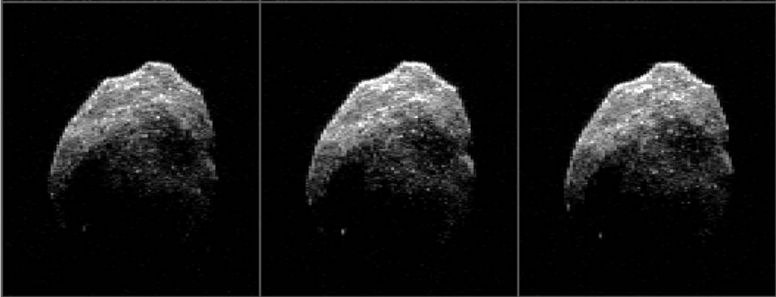New radar images of the ‘spooky’ 2015 TB145 asteroid

The 'spooky' 2015 TB145 asteroid has made a safe pass trough Earth's neigborhood on October 31, 2015, and scientist were able to obtain new high resolution radar images of its surface, quite distinct to the first images provided by the Arecibo radar on October 30. The images were obtained by using the DSS-14 antenna at Goldstone, California and show previously unseen concavities, bright spots and other complex features.
Radar images were acquired during asteroid's pass on October 31, late UTC afternoon when the object was located about 1.3 lunar distances (499 000 km or 310 000 miles) from Earth.
The scientists have utilised the 70-meter (230-feet) antenna to transmit microwaves of high power toward the asteroid. The waves then reflected and scattered from the 2015 TB145's surface and radar echoes were received by the National Radio Astronomy Observatory's (NRAO) 100-meter (330-feet) Green Bank Telescope in West Virginia.

Radar images received by the Green Bank Telescope reveal new details of the surface of asteroid 2015 TB145. Image credit: NASA/JPL-Caltech/GSSR/NRAO/AUI/NSF
Obtained images are of a high quality spatial resolution of 4 meters (13 feet) per pixel which enabled researchers to gather new information about the asteroid's surface features.
Asteroid 2015 TB145 is spherical in shape and estimated to be about 600 meters (2 000 feet) in diameter.
"The radar images of asteroid 2015 TB145 show portions of the surface not seen previously and reveal pronounced concavities, bright spots that might be boulders, and other complex features that could be ridges,The images look distinctly different from the Arecibo radar images obtained on October 30 and are probably the result of seeing the asteroid from a different perspective in its three-hour rotation period,"said Lance Benner of NASA's Jet Propulsion Laboratory in Pasadena, California, who leads NASA's asteroid radar research program.
The asteroid 2015 TB145 will next approach our plaent in September 2018, however that will only be a distant pass, at about 38 million km (24 million miles), which is approximately one quarter of the distance between Earth and Sun.
Featured image: Radar images received by the Green Bank Telescope reveal new details of the surface of asteroid 2015 TB145. Credit: NASA/JPL-Caltech/GSSR/NRAO/AUI/NSF.

Hi i may of seen this Asteroid TB145 by accident from down here in the Southern hemisphere Feilding NZ. Between 12.15am & 12 35am on 31st October . At First i did not know that the Astroid TB145 was coming as I thought it was just a brighter than usual falling star. Also once i thought it was unusual when it streaked across our southern sky with a much slower longer tail. It shot in across from high North direction headed towards North East. A Fire ball red colour first then 2 seconds a blank gap then into a blue with blue white gas cloud tail trailing behind. All in all lasted about 3.5 seconds.
The last Meter I have ever encounted even closer by accident was back in 1985 on a Friday night at 10.37pm. Came shooting low overhead of me from the south west headed north east and it was scary & loud like a sonic boom I had to block my ears for the noise and the ground shook with my hair on the back of my legs standing up with the vibrations. Pretty cool anyway others saw it too in NZ that night I think it was in October or November in the beginning of our summertime. Thanks from Dyna